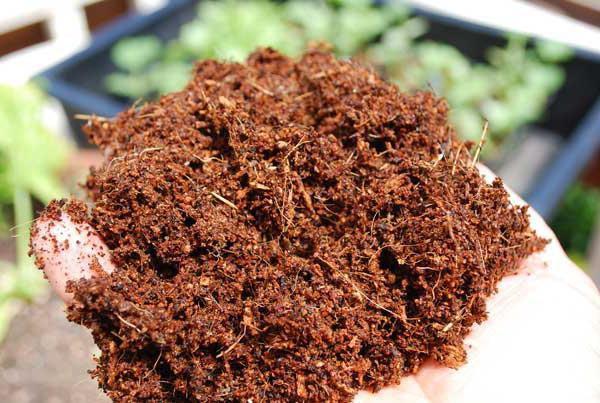Coconut substrate - seedlings and other crops in complete safety
 Tomatoes, eggplants, peppers, and coconut are great companions for the adventurous gardener. Many experts advise growing seedlings in just such a soil mixture. Nevertheless, a number of questions arise: is it worth disinfecting it, adding fertilizing for seedlings, and also where else is the shell of an exotic fruit used?
Tomatoes, eggplants, peppers, and coconut are great companions for the adventurous gardener. Many experts advise growing seedlings in just such a soil mixture. Nevertheless, a number of questions arise: is it worth disinfecting it, adding fertilizing for seedlings, and also where else is the shell of an exotic fruit used?
In such a light and airy planting material, the rhizomes develop much better. They grow strong, and most importantly, unusually branched.
Coconut substrate and its uses
Products are sold in briquettes that are diluted with water. In half an hour, they swell and you get a whole bucket of loose soil. It is so saturated with oxygen that it creates the most favorable conditions for the development of seeds, and later the root system. Nevertheless, seedlings that have 3-4 full-fledged leaves need more nutrients. Unfortunately, they are not in the coconut substrate, so complex fertilizers are introduced into it over time.
There is no need to disinfect the soil. Still, some people treat it with a phytosporin solution. The biological agent saturates the soil with beneficial microorganisms, and also suppresses harmful pathogens of various diseases.
Also, an amazing soil mixture is used to breed capricious plants. It is the structure of their root system that influences the choice of planting land. Therefore, coconut mass is added to the universal soil when planting crops such as:
- violets;
- tuberous varieties that need porous soil, because they do not tolerate stagnant water;
- bulbous varieties;
- calla lilies or geraniumplanted in containers.
They try to adhere to a ratio of 1: 3, but at the same time they constantly check the structure of the earth by touch. To create a lighter substrate, more loose raw materials are introduced.
The porous structure of the substrate contributes to the full development of tubers, and also protects them from decay.
Other options
Many people complain that "Amaranth Khvostaty" and "Ageratum" grow very poorly. Seeds that are too small may be the cause. However, the network is a great option to fix everything:
- make grooves;
- make them coconut raw materials;
- sow seeds;
- fall asleep with the same substrate.
Due to the fact that it does not form a dry crust, tender sprouts are easy to hatch and sprout. The procedure is carried out in a greenhouse or on the garden bed itself. Among other things, with its help:
- Loosens heavy / coarse soils - wet or clayey. When planting roses, hydrangeas or chrysanthemums, mix the earth in half with coconut shells.
- The beds are mulched. Instead of compost, it serves as organic material, as it decomposes later.
- Seedlings are kicked out. Used for germination of plants with a long growing season. As a result, they bloom ahead of time. Yet later they dive into more nutritious soil.
If at one time it was not possible to use all the prepared raw materials, then you do not need to preserve it, sealing it with a lid. You can just leave it to dry. If necessary, seven are again filled with water.
It is important to take into account that the coconut substrate has a neutral reaction, which is important for many crops. As you can see, the usual shell of an exotic fruit guarantees the productive development of seedlings.